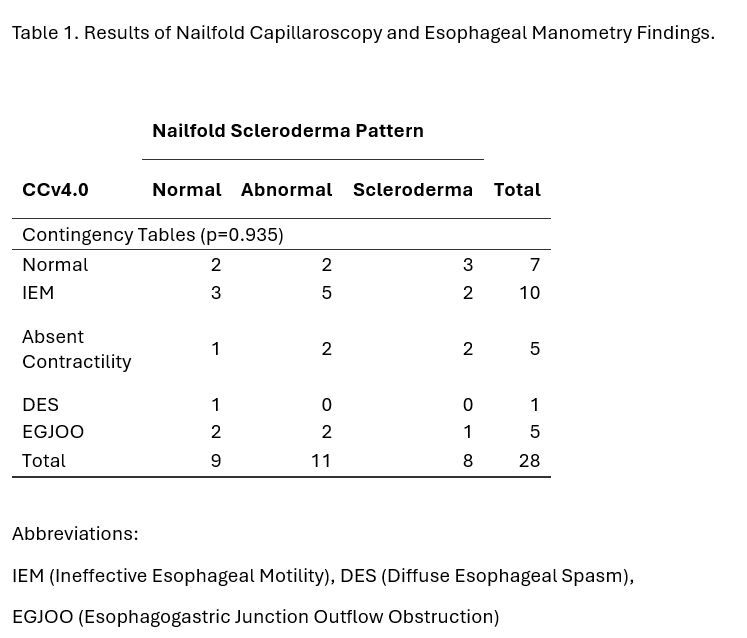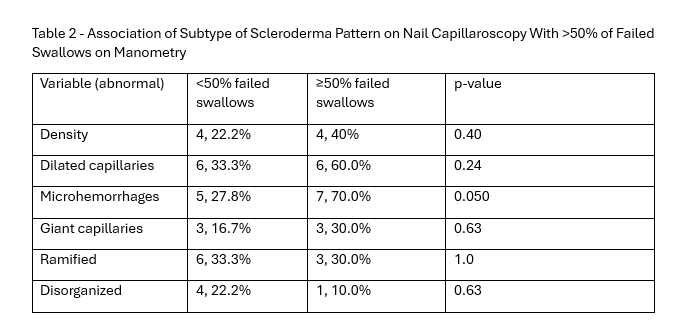Sunday Poster Session
Category: Esophagus
P0673 - Microhemorrhages on Nailfold Video Capillaroscopy Are Associated With ≥50% Failed Peristalsis on High-Resolution Esophageal Manometry
Sunday, October 26, 2025
3:30 PM - 7:00 PM PDT
Location: Exhibit Hall
- TL
Tian Li, MD, MS (she/her/hers)
Mayo Clinic
Jacksonville, FL
Presenting Author(s)
Tian Li, MD, MS, Sehreen Mumtaz, MD, Berianu Florentina, MD, Kenneth Devault, MD, Dawn Francis, MD, Andree Koop, MD
Mayo Clinic, Jacksonville, FL
Introduction: Nailfold video capillaroscopy (NVC) is a non-invasive, safe tool to evaluate the microcirculation morphology in patients with suspected scleroderma, recently incorporated into diagnostic classification criteria and used to monitor disease progression. Esophageal symptoms such as gastroesophageal reflux disease, dysphagia and motility disorders including ineffective esophageal motility (IEM), and absent contractility are common in scleroderma. We aimed to assess the association of nailfold capillaroscopy findings with high-resolution esophageal manometry (HRM) results in patients evaluated for scleroderma.
Methods: This was a retrospective study of patients assessed for scleroderma who underwent both NVC and HRM at Mayo Clinic Florida from 2020 to 2024. We collected demographic information and data including rheumatologic diagnosis, NVC findings, and HRM results. Abnormalities assessed on NVC were those characteristics of the ‘scleroderma pattern’ including abnormal capillary density, capillary dilation, microhemorrhages, giant capillaries, ramified appearance, and disorganized appearance. HRM studies were classified by the Chicago Classification version 4.0 (CCv4.0)
Results: Of 28 patients included patients, 16 (57.1 %) were women with a median age of 60 years (range 25-80) and 26 (92.9%) Caucasian. Rheumatological diagnoses included 8 scleroderma, 4 mixed connective tissue disease, 8 rheumatological process but not scleroderma, 8 not meeting criteria for a rheumatological disorder. On HRM, 7 (25.0%) were normal, 10 patients (35.7%) met CCv4.0 criteria for IEM, 5 (17.9%) absent contractility, 5 (17.9%) esophagogastric outflow obstruction (EGJOO), and 1 (3.6%) distal esophageal spasm (DES). By NVC, 9 (32.1%) of patients were normal, 11 (39.3%) abnormal, and 8 (28.6%) met criteria for scleroderma pattern (giant capillaries, microhemorrhages, loss of capillary density and abnormal shapes). Scleroderma pattern on NVC was not predictive of IEM classification (p=0.067), however the presence of microhemorrhages was correlated with >50% failed peristalsis on HRM (p=0.05).
Discussion: In this study,a scleroderma pattern on NVC was not associated with esophageal dysmotility although this study may be limited by power. However, presence of microhemorrhages did associate with >50% failed peristalsis. These findings suggest that certain findings on nailfold capillaroscopy such as microhemorrhages may be useful to predict esophageal dysmotility and future research with larger patient cohorts are needed

Figure: Table 1. Results of Nailfold Video Capillaroscopy and Esophageal Manometry Findings

Figure: Table 2 - Association of Subtype of Scleroderma Pattern on Nailfold Video Capillaroscopy with >50% of Failed Swallows on Manometry
Disclosures:
Tian Li indicated no relevant financial relationships.
Sehreen Mumtaz indicated no relevant financial relationships.
Berianu Florentina indicated no relevant financial relationships.
Kenneth Devault indicated no relevant financial relationships.
Dawn Francis indicated no relevant financial relationships.
Andree Koop indicated no relevant financial relationships.
Tian Li, MD, MS, Sehreen Mumtaz, MD, Berianu Florentina, MD, Kenneth Devault, MD, Dawn Francis, MD, Andree Koop, MD. P0673 - Microhemorrhages on Nailfold Video Capillaroscopy Are Associated With ≥50% Failed Peristalsis on High-Resolution Esophageal Manometry, ACG 2025 Annual Scientific Meeting Abstracts. Phoenix, AZ: American College of Gastroenterology.
Mayo Clinic, Jacksonville, FL
Introduction: Nailfold video capillaroscopy (NVC) is a non-invasive, safe tool to evaluate the microcirculation morphology in patients with suspected scleroderma, recently incorporated into diagnostic classification criteria and used to monitor disease progression. Esophageal symptoms such as gastroesophageal reflux disease, dysphagia and motility disorders including ineffective esophageal motility (IEM), and absent contractility are common in scleroderma. We aimed to assess the association of nailfold capillaroscopy findings with high-resolution esophageal manometry (HRM) results in patients evaluated for scleroderma.
Methods: This was a retrospective study of patients assessed for scleroderma who underwent both NVC and HRM at Mayo Clinic Florida from 2020 to 2024. We collected demographic information and data including rheumatologic diagnosis, NVC findings, and HRM results. Abnormalities assessed on NVC were those characteristics of the ‘scleroderma pattern’ including abnormal capillary density, capillary dilation, microhemorrhages, giant capillaries, ramified appearance, and disorganized appearance. HRM studies were classified by the Chicago Classification version 4.0 (CCv4.0)
Results: Of 28 patients included patients, 16 (57.1 %) were women with a median age of 60 years (range 25-80) and 26 (92.9%) Caucasian. Rheumatological diagnoses included 8 scleroderma, 4 mixed connective tissue disease, 8 rheumatological process but not scleroderma, 8 not meeting criteria for a rheumatological disorder. On HRM, 7 (25.0%) were normal, 10 patients (35.7%) met CCv4.0 criteria for IEM, 5 (17.9%) absent contractility, 5 (17.9%) esophagogastric outflow obstruction (EGJOO), and 1 (3.6%) distal esophageal spasm (DES). By NVC, 9 (32.1%) of patients were normal, 11 (39.3%) abnormal, and 8 (28.6%) met criteria for scleroderma pattern (giant capillaries, microhemorrhages, loss of capillary density and abnormal shapes). Scleroderma pattern on NVC was not predictive of IEM classification (p=0.067), however the presence of microhemorrhages was correlated with >50% failed peristalsis on HRM (p=0.05).
Discussion: In this study,a scleroderma pattern on NVC was not associated with esophageal dysmotility although this study may be limited by power. However, presence of microhemorrhages did associate with >50% failed peristalsis. These findings suggest that certain findings on nailfold capillaroscopy such as microhemorrhages may be useful to predict esophageal dysmotility and future research with larger patient cohorts are needed

Figure: Table 1. Results of Nailfold Video Capillaroscopy and Esophageal Manometry Findings

Figure: Table 2 - Association of Subtype of Scleroderma Pattern on Nailfold Video Capillaroscopy with >50% of Failed Swallows on Manometry
Disclosures:
Tian Li indicated no relevant financial relationships.
Sehreen Mumtaz indicated no relevant financial relationships.
Berianu Florentina indicated no relevant financial relationships.
Kenneth Devault indicated no relevant financial relationships.
Dawn Francis indicated no relevant financial relationships.
Andree Koop indicated no relevant financial relationships.
Tian Li, MD, MS, Sehreen Mumtaz, MD, Berianu Florentina, MD, Kenneth Devault, MD, Dawn Francis, MD, Andree Koop, MD. P0673 - Microhemorrhages on Nailfold Video Capillaroscopy Are Associated With ≥50% Failed Peristalsis on High-Resolution Esophageal Manometry, ACG 2025 Annual Scientific Meeting Abstracts. Phoenix, AZ: American College of Gastroenterology.
